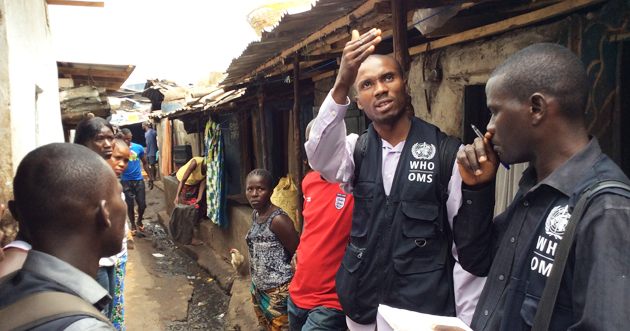
Moa Wharf is one of Sierra Leone’s worst slums. In this overcrowded, beachfront neighbourhood, Ebola arrived and seemed poised to burn through the area like wildfire. So how did one of the most challenging areas in Sierra Leone get to zero cases and how can the Ebola response learn from its success?

On a stretch of scenic coastline at the edge of the Atlantic Ocean sits one of Freetown, Sierra Leone’s, toughest neighbourhoods – Moa Wharf. It is a cluster of congested, tightly-packed corrugated iron and brick homes and shops. The passageways are narrow and crowded. Residents and visitors find themselves in close, intimate contact as they navigate swampy land and heaps of refuse. Pigs run loose on the streets, rooting through the garbage and adding their waste to an already fetid situation. So how did the area with one of the most challenging and daunting environments manage to reach zero cases?
The first case of Ebola occurred around 9 March 2014. As a result of this initial case, the Government instituted a quarantine, which was lifted on 10 April following the last positive case on 26 March. But with more than 8 000 people living in this area that is less than 1 square kilometre, Ebola response teams were fearful that the virus would re-emerge in this enclave.
A death in the community
On 15 April those fears became a reality when teams received word of a death in the community – a 34-year old fisherman who presented Ebola symptoms, tested positive in a post-mortem examination. Disease surveillance officers, epidemiologists and WHO social mobilization teams assisted in identifying a 22-year old commercial biker as the possible index case. He also tested positive for Ebola and died on 17 April. Three additional individuals who were infected were also found following further investigations.
Immediately after these cases were identified and confirmed, the Ministry of Health, WHO, UNICEF, Médecins Sans Frontières, other partners, local leaders, members of various task forces and 2 local chiefs mounted an intensive community engagement and social mobilization programme to end the Ebola outbreak.
Getting to zero starts and ends with the community
Mr Osman Kabia, a WHO social mobilization team lead, encouraged his team to embrace this philosophy: for all community engagement and social mobilization activities “in all outbreaks where solutions in stopping an outbreak are needed, particularly where communities are involved, all strategies, planning and activities should start with the community and end with the community.”
Doing this involved meetings with the community landlords, traditional healers, religious leaders, survivors, chiefs, community taskforce members, harbour masters and other key community members. Total community participation and involvement had been lacking when the earlier cases occurred. As Chief Pa Alimamy Komeh Ka-pen put it, “Moa Wharf community was abandoned and left to fend for itself.”
The teams were determined not to repeat that mistake and developed a strategy for the whole community. The WHO social mobilization team divided the area into 5 zones. Each team included an epidemiologist, a district surveillance officer, and was primarily made up of community members. These teams were responsible for winning the hearts and minds of the residents of Moa Wharf to accept the Ebola messages and gain greater awareness of the disease outbreak within their community.
Taskforce members consisting of young adults selected from Moa Wharf were also part of the teams. They included members of the Three Poli Boys, a local fraternal society with significant influence, who helped to conduct active case investigations. The also helped on the search for sick members of the community, regardless of their disease symptoms.
Survivors provide support in finding and following cases

Within these teams, Ebola survivors also played a critical role in the contact tracing efforts. They were instrumental in providing key messages to those within quarantined homes and ensured that anyone who was on a contact list was seen every day.
They, along with other community members, assisted with searches along the seashores, where transmission of the virus was most active among young men involved in secret fraternal societies.
Prior to this, survivors were not part of the community engagement, but that changed during the response in Moa Wharf. The survivor strategy proved to be a success for the social mobilization, disease surveillance and epidemiological teams in containing and ending the Ebola outbreak in the area.
“For the Ebola response teams, it was encouraging to be able to mobilize the community and transform deep-seated beliefs that had initially thwarted positive intervention and response activities,” said WHO medical officer, Dr Kande-Bure K.B. Kamara.
Building the trust and confidence
Choosing the best approach and interventions is key in order to continue building trust and confidence with the community. To do this, the social mobilization teams leaned away from another quarantine and instead relied on the strong relationships that had been built to spread the right messages. “Quarantining a whole community where soldiers and police officers are utilized for security purposes is not the answer to ending the transmission chain,” said Mr Kabia . “It will only elevate the fear of the community and lead to sick members going into hiding.”
The Moa Wharf community is now fully aware of the reality and dangers of Ebola and have been proactive in taking ownership of outreach and sensitization programmes. Their collaboration with the various response teams has been invaluable and they have shown energy, drive and a willingness to end the outbreak. Relationships with the international response community are stronger and community members believe in the process of being the gatekeepers for keeping their neighbourhood safe and vigilant.
The Moa Wharf community stands as a testament of an efficient, timely and respectful Ebola response and serves as a model for getting to zero.
W.H.O


